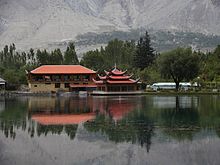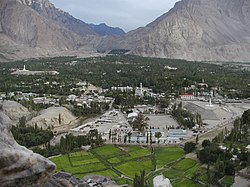Skardu
From Wikipedia, the free encyclopedia
| Skardu | |
|---|---|
| Skardu Town as seen from the Skardu Fort | |
| Coordinates: 35°18′N 75°37′E / 35.3°N 75.617°ECoordinates: 35°18′N 75°37′E / 35.3°N 75.617°E | |
| Country | |
| Province | Gilgit Baltistan |
| Time zone | PST (UTC+5) |
| - Summer (DST) | GMT+5 (UTC+6) |
Skardu is located in the 10 km wide by 40 km long Skardu Valley, at the confluence of the Indus river (flowing from near Kailash in Tibet and through neighbouring Ladakh before reaching Baltistan) and the Shigar River. Skardu is situated at an altitude of nearly 2,500 m (8,200 ft). The town is surrounded by grey-brown coloured mountains, which hide the 8,000 metre peaks of the nearby Karakoram range.[citation needed]
Contents |
[edit] Tourism, trekking and mountain expedition base
Skardu, along with Gilgit, are the two major tourism, trekking and expedition hubs in Pakistan-administered Kashmir. The mountainous terrain of the region, including four of the world's fourteen Eight-thousander peaks (8,000 m and above), attracts the attention of tourists, trekkers and mountaineers from around the world. The main tourist season is from April to October; outside this time, the area can be cut off for extended periods by the snowy, freezing winter weather.[citation needed]Accessible from Skardu by road, the nearby Askole and Hushe Valleys are the main gateways to the snow covered 8,000 m peaks including K2, the Gasherbrums, Broad Peak and the Trango Towers, and also to the huge glaciers of Baltoro, Biafo and Trango. This makes Skardu the main tourist and mountaineering base in the area, which has led to the development of a reasonably extensive tourist infrastructure including shops and hotels. However, the popularity of the region results in high prices, especially during the main trekking season.[citation needed]
Treks to the Deosai Plains, the second highest in the world (at 4,100 m or 13,500 feet) after the Chang Tang in Tibet, either start from or end at Skardu. In local Balti language, Deosai is called Byarsa, meaning 'summer place'. With an area of approximately 3,000 square kilometres, the plains extend all the way to Ladakh and provide habitat for snow leopards, ibex, Tibetan brown bears and wild horses.[citation needed]
The Satpara Dam Project on the Satpara Lake is a project inagaurated in 2002 and due to be completed by December 2010. It is 7 km away from Skardu city and its altitude is 8,700 feet (2,700 m) moreover it will also pond the water about 90,000 acre feet (110,000,000 m3). The main source of water is melting ice of the Deosai plains during the summer season.[citation needed]
It is a multipurpose project, which will produce 13 Megawatts hydro generation, irrigate 15,000 acres (61 km2) of land and also provide 13 cusecis drinking water daily to Skardu city.
On 29 August 2009, the Gilgit-Baltistan Empowerment and Self-Governance Order 2009, was passed by the Pakistani cabinet and later signed by the President Asif Ali Zardari. It granted self-rule to the people of the former Northern Areas, now renamed "Gilgit-Baltistan," by creating, among other things, an elected legislative assembly.On the other hand there has been criticism and opposition to this move by Pakistan inside Pakistan, India, and the Gilgit-Baltistan region itself.[citation needed]
[edit] The town and the local people
The town has developed along the main road passing through it and to either side of this road is situated the New Bazaar (Naya Bazaar), with hundreds of shops offer almost everything (trekking supplies, souvenirs, local goods, etc.). To the west one finds Yadgar Chowk (with local monument) and from there, the quarter behind Naya Bazaar, to the right hand side is the older Purana Bazaar. Travelling west from Naya Bazaar is a polo ground and next to that, Kazmi Bazaar.[citation needed]Skardu appears remote, dusty town at first glance, but the mixture of people here make it colourful and ethnically diverse. The crowded streets are mainly populated by Balti Tibetans and many of the local neighbourhoods (mohallahs) have names that reflect this too (i.e. Khache-drong, Khar-drong, Olding, Kushu-bagh, Pakora, Thsethang, Sher-thang, Nagholi-spang etc.). Due to this strong presence, Skardu has sometimes been referred to as the little Tibet of Pakistan.[citation needed]
However, many other ethnic groups are present in Skardu including Shins, Pashtuns, Punjabis, Hunzakuts and even Uyghur, due to the close proximity of Baltistan to the respective regions. Since the creation of Pakistan people of various ethnicities from various regions of Pakistan have emigrated here.[citation needed]
All the above ethnic groups are devout Muslims. This includes the Balti-Tibetans, who converted from Tibetan Buddhism in the 16th century (the only sizeable group of Tibetans to have undergone such a conversion). Shia Islam has a strong presence in Skardu.[citation needed]
Famous personalities of Skardu valley. Prof. Ghulam Hussain Saleem, present member Gilgit-Baltistan Council and adviser to Prime Minister for Gilgit Baltistan affairs, also a very high calibre religious scholar, S.Mehdi Shah, present chief minister of Baltistan Province. Sheikh Nisar of Gamba. Fida Mohamad Nashad of Hussain Abad. Wazir Shakeel Agha of Ali Abad. Syed Ahmad Ali Shah of Gamba.[citation needed]

Entrance to the Skardu Fort
[edit] Weather and climate
The climate of Skardu during the summer is moderated by its mountain setting and the intense heat of lowland Pakistan does not reach here. The mountains also block out the summer monsoon and summer rainfall is thus quite low. However, these mountains result in very severe winter weather. During the April to October tourist season, temperatures vary between a maximum of 27 °C and a minimum (in October) 8 °C. However, temperatures can drop to below -10 °C in the December-to-January midwinter period. The lowest temperature of the year can reach -25 °C[citation needed]
Shangrila Resort, Skardu
[edit] Transport
Skardu is accessible by two methods, road or air. The normal road route into Skardu is via the Karakorum Highway and a linkroad into the Skardu Valley from it. There are also four or five other road links to Kashmir and Ladakh. Alternatively, there are normally one or two flights daily between Skardu Airport and Islamabad. The high cost of air travel means that road travel via the Karakorum Highway and the link road onward to the Skardu Valley is often the preferred option of locals and tourists alike.[citation needed]The climate can have adverse affects on transport in and out of the Skardu Valley, as Skardu becomes snowbound during the winter months. Often the roads in and out of Skardu (and other Northern Areas locations) can be blocked for weeks at a time depending on conditions (though two to five days is more normal), sometimes leaving air travel as the only feasible alternative. However, air travel in winter is also subject to disruption due to the unreliable Skardu weather and flights can occasionally be delayed by several days.[citation needed]
[edit] Skardu Fort (Kharphocho Fort)
Skardu Fort or Kharphocho Fort lies on the eastern face of the Khardrong or Mindoq-Khar ("Castle of Queen Mindoq") hill 15 metres or 40 feet (12 m) above Skardu town. The fort dates from the 8th Century CE and contains an old mosque probably dating back to the arrival of Islam in the 16th Century CE. The fort provides a panoramic view of Skardu town, the Skardu valley and the Indus River. The fort was built by Rmakpon dynasty rulers of Baltistan and it was a seven storey building. It was burnt down by Sikhs in the 18th Century CE.[citation needed]Kharphocho (Skardu) fort was built on a design similar to that of Leh Palace and the Potala Palace in Lhasa, Tibet. The name Kharpochhe means the great fort — Khar in Tibetan means castle or fort and Chhe means great.[citation needed]
[edit] Shigar Fort
Located on the legendary route to the world’s second highest mountain K-2, and known as Fong-Khar, which in the local language means the “Palace on the Rock”. The complex at Shigar comprises the 400-year-old Fort / Palace and two more recent buildings, the "Old House" and the "Garden House". The former Palace of the Raja of Shigar has been transformed into a 20 room heritage guesthouse, with the grand audience hall serving as a museum of Balti culture and featuring select examples of fine wood-carvings, as well as other heritage objects.[citation needed][edit] Skardu Road
Cricklewood's North - South avenue takes its name from the fort of the same name.[1][edit] Lakes near Skardu
There are three lakes in the vicinity of Skardu. In local Balti-Tibetan language, a lake is a thso or tso.[citation needed][edit] Kachura Lakes
There are two Kachura Lakes—the less well known Upper Kachura lake and the more famous Lower Kachura Lake, better known as Shangrila Lake. Lower Katsura lake is home to the Shangrila Resort hotel complex (possibly the reason for the lake's alternative name), built in a Chinese style and another popular destination for tourists in Pakistan. The resort has a unique style of restaurant, set up inside the fuselage of an aircraft that crashed nearby. Kachura lake 18m from Skardu. Kachura Lake is famous for its deep blue waters. There are numerous places to visit and things to do near Kachura Lake, situated near Skardu in the northern area.[citation needed][edit] Satpara Lake
Sadpara Lake is Skardu Valley's main lake, supplying water for Skardu town, and reputedly one of the most picturesque lakes in Pakistan. In 2002, the Government of Pakistan decided to build a dam on the Satpara Lake[2] allocating Rs. 600 million ($10 million) to the Satpara Dam project, two years later in 2004.[2] Progress on the project has, however, been slow.[3] Satpara Lake is 6 miles (9.7 km) from Skardu. Satpara Lake is one of the largest fresh water lakes in the country offering trout fishing, and row boating. This lake is also responsible for the drinking water that is supplied in Skardu. Satpara Lake is a beautiful lake which is situated near Deosai the second highest plain area in the world. this was very small dam of Pakistan.During the construction of the dam descon compony complete this work at 11years[edit] Sister cities
[edit] See also
[edit] References
- ^ Punjab - Imperial Gazetteer of India, v. 20, p. 269
- ^ a b "Your Source of News on the World Wide Web". Archive. dawn.com. http://www.dawn.com/2004/06/21/local26.htm.
- ^ "Your Source of News on the World Wide Web". Archive. dawn.com. http://www.dawn.com/2006/03/22/top13.htm.
- ^ "Italy offers to upgrade Skardu airport". The Express Tribune. http://tribune.com.pk/story/111663/italy-offers-to-upgrade-skardu-airport/.
[edit] Further reading
- Jettmar, Karl et al. (1985): Zwischen Gandhara und den Seidenstrassen: Felsbilder am Karakorum Highway: Entdeckungen deutsch-pakistanischer Expeditionen 1979-1984. 1985. Mainz am Rhein, Philipp von Zabern.
- Jettmar. Karl (1980): Bolor & Dardistan. Karl Jettmar. Islamabad, National Institute of Folk Heritage.
- piac.com.pk page about Northern Areas
[edit] External links
- Blankonthemap The Northern Kashmir WebSite
- The Changing Northern Areas
- Photos from Skardu, Kachura Lake and Satpara Lake by Waqas Usman
- Photos from Skardu and Kachura Lake by Arif Khan
- Photos from Skardu and Kachura Lake by Asher Yaqub Khan
- Photos from Skardu by Ole Holbech
| ||||||||||||||||||||||||||
View page ratings
Rate this page
Saved successfully
Your ratings have not been submitted yet
Your ratings have expired
Thanks! Your ratings have been saved.
Thanks! Your ratings have been saved.
An account will help you track your edits, get involved in discussions, and be a part of the community.
or Thanks! Your ratings have been saved.



No comments:
Post a Comment